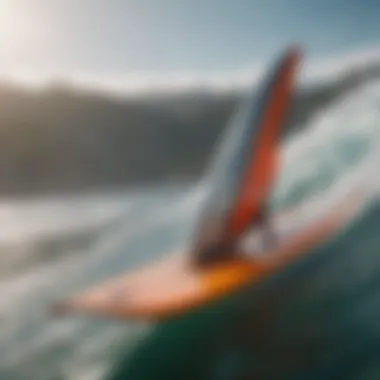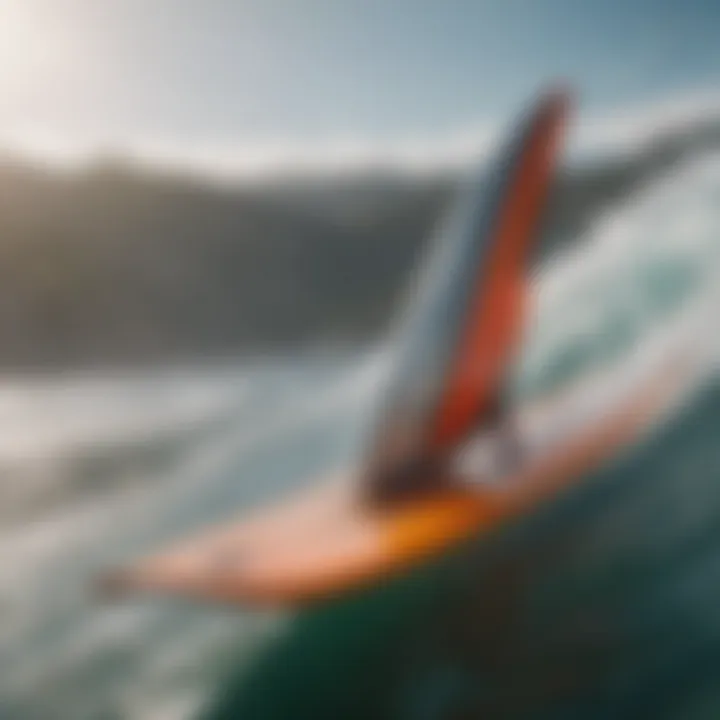Hydrofoil Surfing Boards: Innovations and Insights


Intro
Hydrofoil surfing boards represent a leap in water sports technology. Their unique design and function allow surfers to glide above the water, creating an exhilarating experience that differs significantly from traditional surfing. Understanding these boards is essential for enthusiasts and newcomers alike.
The hydrofoil system comprises a foil that extends below the board. This setup lifts the rider above the surface of the water, minimizing drag and enabling faster speeds. The physics behind hydrofoil surfing involves principles of lift and buoyancy, distinguishing it from conventional surfing techniques.
The evolution of hydrofoil technology has gained momentum over recent years, making these boards more accessible and efficient for a broader audience. Different brands and models are emerging, catering to various skill levels and preferences.
This article aims to provide a comprehensive guide to hydrofoil surfing boards. We will explore the designs and their impact on the sport, discuss safety guidelines, techniques for various levels, and the resulting environmental considerations.
Equipment Reviews
The right equipment significantly enhances the hydrofoil surfing experience. Each component, from the boards to accessories, plays a vital role in performance and safety. In this section, we will review the main aspects of hydrofoil equipment.
Boards: Design and Construction
Hydrofoil boards come in various designs tailored to specific riding styles. The most common types include:
- Freeride Boards: Based for versatility and ease of use, suitable for beginners.
- Race Boards: Built for speed and efficiency, these boards have a narrower width and lighter construction.
- Surf Foil Boards: Tailored for wave riding; these boards generally have more volume and a specific shape for better performance.
When selecting a hydrofoil board, consider its construction materials. Most boards utilize materials like fiberglass or carbon fiber for lightweight yet durable performance. The board's size also influences maneuverability and stability.
Accessories: Essential Gear
A few critical accessories enhance the hydrofoil surfing experience:
- Foils: Varying in shape and size, foils influence lift and control. A higher aspect ratio foil typically offers more speed, but stability may lessen.
- Footstraps: Essential for controlling the board; adjustable straps enable a comfortable ride.
- Safety Gear: Helmets and impact vests protect riders in case of falls, making them essential for both novices and experienced surfers.
Regularly check the condition of your equipment to ensure safety. Inspecting for wear and tear can help prevent accidents and prolong the life of your gear.
Culmination
Understanding hydrofoil surfing boards and their components is crucial for enjoying this innovative sport. The right board and equipment not only enhance performance but also promote safety on the water.
Understanding Hydrofoil Technology
Hydrofoil surfing has gained a lot of attention over the past few years. Understanding hydrofoil technology is essential for anyone interested in this innovative sport. Hydrofoils are designed to lift a board above the water, allowing surfers to glide smoothly along the surface. This technology enhances speed and reduces drag. The board and foil work together to create a unique riding experience. Understanding the interplay of these components informs better decisions on design and performance attributes.
Furthermore, recognizing the mechanics of hydrofoil technology helps surfers to enhance their skills. This knowledge also contributes to improved safety. Knowledgeable riders can anticipate interactions with water conditions and equipment. Therefore, understanding hydrofoil technology is a vital part of engaging effectively with this exhilarating activity.
The Basics of Hydrofoil Design
Hydrofoil design centers on a wing-like structure attached to a board. The foil generally consists of three main parts: the mast, the fuselage, and the wings. The mast connects the foil and the board, while the fuselage links the wings to the mast. The wings are crucial as they generate lift, allowing the board to rise above the water.
A well-designed hydrofoil optimizes water flow beneath it. The shape and angle of the wings are critical. They are engineered to balance lift and stability. Hydrofoil boards can be further customized based on riding style and conditions. Some boards feature longer masts for deeper water, while others have shorter masts for more maneuverability. Each design choice impacts performance and rider experience.
Physics of Lift and Drag
The concept of lift and drag is fundamental in hydrofoil surfing. Lift occurs when the wing moves through water, creating an upward force. This force must overcome the weight of the surfer and board. The design of the wing plays a pivotal role in this process.
Drag, on the other hand, is the resistance a foil faces through the water. Effective hydrofoil design seeks to minimize drag while maximizing lift. A well-constructed foil reduces drag by maintaining a streamlined shape. Surfers must also be aware of their body position to manage lift and drag during a ride.
"Understanding the physics behind lift and drag is essential for mastering hydrofoil surfing. Proper body positioning and board control can greatly influence performance."
In summary, both lift and drag are crucial. Their interaction dictates performance and efficiency. Understanding these principles enables surfers to maximize their experience while navigating various water conditions.
Components of Hydrofoil Surfing Boards
Understanding the components of hydrofoil surfing boards is essential for anyone engaging with this sport. Each part contributes to overall performance, allowing riders to experience enhanced capabilities on the water. The design and functionality of hydrofoil boards have undergone significant advancements. These improvements have made it crucial for both new and experienced riders to grasp the importance of these components.
The Foil: Structure and Function


The foil is the heart of any hydrofoil surfing board. It typically consists of three main parts: the mast, the wings, and the stabilizer. The mast connects the board to the wings. It is usually made from strong, lightweight materials like aluminum or carbon fiber. The wings are crucial for lift; they act similarly to airplane wings, generating upward thrust as the board moves through water. This lift allows surfers to ride above the surface, reducing drag.
The stabilizer helps maintain balance during the ride. Its position affects the board's responsiveness and stability. A well-designed foil will optimize lift while minimizing drag, enabling smoother rides even in choppy conditions.
Board Construction Materials
The materials used in hydrofoil board construction play a pivotal role in performance and durability. Common materials include fiberglass, carbon fiber, and epoxy resin. Fiberglass boards are durable and versatile, making them appealing to a wide range of surfers.
In contrast, carbon fiber boards offer higher performance due to their lighter weight. This quality enhances speed and maneuverability. However, they can be more expensive. Additionally, epoxy resin is often used in combination with these materials to create a waterproof barrier, protecting the inner structure of the board.
Choosing the materials wisely impacts not only performance but also the long-term maintenance of the board. Understanding how each material contributes to the board's functional aspects is beneficial.
Choosing the Right Size and Shape
Selecting the appropriate size and shape of a hydrofoil surfing board is important for optimizing performance. Factors such as the rider's skill level, weight, and intended riding conditions can influence this decision.
For instance, longer boards tend to provide more stability, making them suitable for beginners. On the other hand, shorter boards give advanced riders more agility for tricks and maneuvering. Additionally, the width of the board affects buoyancy. Wider boards offer more surface area, which aids in balance and lift.
To summarize, paying attention to the size and shape of the board can greatly improve the overall riding experience. Each component contributes significantly to how effectively a surfer can engage with the water, making thoughtful selection essential for both performance and enjoyment.
Advantages of Hydrofoil Surfing
Hydrofoil surfing represents a significant innovation in the world of water sports. The advantages of hydrofoil surfing boards extend beyond mere novelty; they enhance the overall surfing experience in profound ways. These boards offer unique features that set them apart from traditional surfing, providing not just excitement, but also a new level of performance. Understanding these benefits is crucial for both enthusiasts and newcomers.
Enhanced Speed and Maneuverability
Hydrofoil boards are designed to reduce water drag, allowing riders to achieve higher speeds with less effort. This speed result from the foil being submerged beneath the surface, leading to less friction compared to a conventional surfboard. The streamlined design gives the rider the ability to glide over waves rather than chop through them.
- This efficiency not only enhances speed but also creates opportunities for sharper turns and greater agility. Riders can navigate quickly through various wave conditions, adapting to changes in the environment in real-time.
- Furthermore, the lift generated by the hydrofoil means that riders can maintain speed even in smaller waves, significantly broadening the conditions under which they can practice hydrofoil surfing.
Riding in Varied Conditions
One of the prominent benefits of hydrofoil surfing boards is their versatility in varied water conditions. Traditional surfing often requires specific types of waves and wind conditions, but hydrofoil technology allows riders to explore a broader range.
- This is particularly beneficial for areas with inconsistent surf. Hydrofoils can lift the rider out of the water and maintain speed even when wind and waves are not ideal.
- Riders can enjoy hydrofoil surfing in light winds, almost flat water, or during choppy conditions, which are typically challenging for conventional surfboards.
This adaptability means more time on the water, enabling surfers to optimize their sessions and hone their skills regardless of the locality. Hydrofoil surfing provides a unique blend of performance and accessibility, encouraging surfers to explore new environments and push the boundaries of what is possible in water sports.
"Introducing hydrofoil technology into surfing expands the horizons of what can be achieved on the water, encouraging creativity and innovation among riders."
Overall, understanding the advantages that hydrofoil surfing boards provide is essential for anyone looking to enhance their water sports experience. The ability to ride faster and in various conditions not only elevates the excitement but also opens new avenues for skill development and enjoyment.
Safety Considerations in Hydrofoil Surfing
Hydrofoil surfing opens a world of excitement and unique experiences on the water. However, the inherent risks associated with this sport require careful attention to safety. Understanding safety considerations is crucial for reducing incidents and enhancing rider confidence. This section delves into essential protective gear and common risks faced by hydrofoil surfers, as well as how to mitigate these challenges for a safe surfing experience.
Protective Gear and Equipment
The right protective gear cannot be understated in hydrofoil surfing. It serves as the first line of defense in the event of unexpected mishaps. Here are key items recommended for any hydrofoil surfer:
- Helmet: A well-fitted helmet can protect against head injuries from falls or collisions. Foam padding absorbs impact effectively.
- Impact Vest: An impact vest provides protection for the torso and can also improve buoyancy, making it easier to float.
- Wetsuit: A good wetsuit keeps body temperature stable in cold waters and also serves to protect from abrasions.
- Leash: A reliable board leash ensures that the board stays attached, reducing the risk of injury to oneself and others.
Investing in quality gear not only enhances safety but also fosters a sense of security, allowing surfers to focus more on their skills and less on potential dangers.
Common Risks and How to Mitigate Them
Hydrofoil surfing, like any extreme sport, carries its share of risks. Some of the most common hazards include:
- Falls: Losing balance can lead to falls, which morph into potential collisions with the board. To reduce this risk, practicing balance on land might help.
- Collisions: Surfers can collide with their boards or other riders. Keeping a safe distance from others and being aware of one's surroundings can significantly minimize this threat.
- Drowning: Though most surfers have swimming skills, the risk of drowning is always present if one gets trapped under the board or loses consciousness in water. Always surf in areas with lifeguards and ensure an emergency plan is in place.
"Safety is never an accident; it's the result of careful planning and preparation."
Mitigation strategies for these risks involve:


- Training: Understanding basic hydrofoil techniques improves confidence and reduces the frequency of falls.
- Buddy System: Surfing with a partner not only makes the experience more enjoyable but also provides assistance in case of an incident.
- Regular Checks: Before taking the board to water, performing routine equipment checks ensures that everything is in proper working order.
Tips for Selecting a Hydrofoil Surfing Board
Selecting the right hydrofoil surfing board is critical for both performance and enjoyment. Given the sport's dynamic nature, various elements come into play when making an informed decision. Understanding your unique preferences and requirements can make a substantial difference in your hydrofoil experience. This guide highlights specific areas to consider, ultimately enhancing your surfing performance and safety.
Understanding Your Skill Level
Your skill level is one of the foremost factors in determining the ideal hydrofoil surfing board. Beginners should look for boards that offer stability and ease of use, making it easier to learn the intricacies of hydrofoil surfing. A shorter and wider board can provide added buoyancy, which helps with balance.
As your skills advance, you might prefer a board that allows for greater maneuverability and speed. Experienced surfers often opt for longer, more narrow boards that promote agility and quicker turning capabilities. Before purchasing, it's advisable to honestly assess where you stand within your skill journey.
Some points to consider:
- Technical Skill: Are you comfortable with traditional surfing?
- Experience with Hydrofoil Gear: Have you tried riding a foil before?
- Preferred Riding Style: Do you enjoy speed or more controlled, slower maneuvers?
Evaluating Board Features
When looking at hydrofoil boards, several features warrant careful evaluation to ensure they meet your needs. This evaluation encompasses both performance characteristics and material quality. Consider the following:
- Foil Positioning: Different board designs have varying foil placements. A forward position can increase lift and acceleration, whereas a rear position may enhance stability.
- Thickness: The board's thickness affects flotation. A thicker board might offer better buoyancy, which is invaluable for beginners.
- Weight: A lighter board enhances responsiveness and ease of transport, but may sacrifice some durability.
- Material: Look for high-quality materials like epoxy or carbon fiber. They are often more durable and provide better performance in various conditions.
"Choosing a board is not just about style; it's about how the board fits with your personality and riding goals."
Maintenance and Care for Hydrofoil Boards
Maintaining and caring for hydrofoil surfboards is essential. Proper upkeep can significantly extend the lifespan of the board and the foil. It also ensures safety while riding. Hydrofoil boards are an investment. Taking time to care for them can yield great benefits.
Keeping a hydrofoil board clean helps resist corrosion and prevents damage from saltwater. Salt buildups can degrade materials over time. Storage also affects the board's performance and integrity. Correct practices can help prevent warping or other issues that occur in extreme conditions. Riders should consider various factors for cleaning and proper storage.
Cleaning and Storage Practices
Cleanliness is crucial for hydrofoil boards. After each session, rinse the board and foil with freshwater. This practice helps remove salt, sand, and debris. When cleaning, use a soft sponge to avoid scratches. Avoid harsh chemicals that could harm the material.
For storage, choose a cool, dry place. Avoid leaving the board in direct sunlight or extreme temperatures. Using a padded bag provides protection during transport. Make sure that the foil is detached before storing the board. This helps prevent unwanted pressure on the board during storage.
Routine Checks and Repairs
Routine checks are vital for ensuring that all components are in good condition. It is essential to inspect the board for any cracks or signs of wear after each use. Pay attention to the foil connections and ensure they are secure. Regularly examining the screws and the mounting hardware can avoid potential accidents.
In case of damages, repair them quickly. Minor issues can escalate if not addressed promptly. For instance, small cracks may lead to more severe structural problems. Use appropriate sealants or adhesives based on manufacturer recommendations. If necessary, consult with professionals for repairs, as some damages require expertise.
"Regular maintenance increases performance and ensures safety while enjoying the ride."
By adhering to proper cleaning, storage, and routine inspection, hydrofoil board riders can maintain their gear's quality and performance for many seasons.
Hydrofoil Surfing Techniques
Hydrofoil surfing techniques encompass the essential skills required to navigate with precision and confidence on hydrofoil boards. Mastery of these techniques is crucial for both enhancing performance and ensuring safety. As hydrofoil surfing gains popularity among kitesurfers and extreme athletes, understanding these techniques can significantly elevate one's experience on the water.
Basic Riding Position and Balance
Achieving the correct riding position is fundamental for effective hydrofoil surfing. Riders should adopt a low stance, bending the knees and keeping the feet shoulder-width apart on the board. This position lowers the center of gravity, which facilitates better balance as the hydrofoil lifts out of the water. Riders need to keep their body weight centered over the foil. Shifting weight too far forward or backward can lead to instability, resulting in potential falls.
In addition to stance, maintaining balance relies on the coordination of body movements. The arms should be slightly spread, used as a counterbalance to shifting weight. It is also essential to use the core muscles to maintain stability. Engaging the core allows for quick adjustments, making it easier to correct balance when needed. The ability to remain relaxed while riding, as opposed to rigid, further supports balance, as a relaxed body can absorb the vibrations and movements better.
"Balance is key; too much weight shifts can send you tumbling over your handlebars and into the water."
Turning and Maneuvering Techniques
Turning and maneuvering are core elements of hydrofoil surfing that require practice and finesse. The turning technique can be initiated by leaning your body into the turn while applying pressure on the heel or toe side of the board. Depending on the desired direction, a subtle weight shift will help direct the hydrofoil through the arc of the turn. Importantly, the rider must maintain enough speed; too much slow-down may cause the foil to sink back into the water.


Riders also need to be aware of the water's surface conditions, as these can affect takeoff and landing during maneuvers. Understanding how the hydrofoil interacts with the water is vital for smooth transitions.
Communication with personal instincts is a significant component; understanding your own comfort with speeds and the turning radius of your foil leads to smoother rides. Practicing slow, controlled turns can build confidence and proficiency before attempting tighter maneuvers or faster transitions.
In summary, hydrofoil surfing techniques involve a combination of balance, position, and maneuvering skills. These elements collectively enable riders to harness the full potential of hydrofoil boards, making it a rewarding pursuit for enthusiasts.
The Environmental Impact of Hydrofoil Technology
Understanding the environmental implications of hydrofoil technology is crucial for the sustainable future of water sports. Although hydrofoil surfing presents various advantages in performance and versatility, it is important to examine its ecological footprint. The integration of innovative materials and environmentally considerate production processes plays a significant role in reducing the impact on our oceans and waterways.
Sustainability in Materials and Production
When discussing sustainability in hydrofoil surfing boards, the focus is primarily on the materials used in construction and the production processes involved. In recent years, manufacturers have started adopting eco-friendly materials, moving away from traditional plastics and non-biodegradable composites. Materials such as recycled foam, bamboo, and flax fiber have gained popularity due to their lower environmental impact.
It's also important how these materials are sourced. Sustainable harvesting, minimal waste during production, and proper recycling at the end of the product's life are critical factors. Some manufacturers are beginning to address these aspects by implementing sustainable practices. For instance, keeping track of the material sourcing chain can help ensure that their components do not contribute to deforestation or habitat destruction.
Another key element is the efficiency in the production process itself. Factories are increasingly adopting energy-saving technologies and waste-reduction methods. By decreasing carbon emissions during manufacturing, companies assist in preserving the delicate balance of marine ecosystems. Choosing brands that prioritize sustainability let consumers contribute positively to the environment while enjoying the sport they love.
Impact on Marine Life
The introduction of hydrofoil surfing boards has implications for marine life that warrant thorough exploration. While many enthusiasts celebrate the thrill of gliding above the water's surface, the proximity to ecosystems raises concerns. Hydrofoils, by design, disturb the water less than traditional boards, but there remain risks that cannot be ignored.
For example, the noise produced by hydrofoils can affect underwater environments. Noise pollution from surfboards may disrupt the communication and navigation of marine animals, especially species like dolphins or whales that rely on echolocation. Understanding this adverse effect is important for maintaining biodiversity in affected areas.
Furthermore, the potential for accidental collisions with marine life is an ongoing concern. Although hydrofoil surfing generally causes minimal turbulence, the speed at which a surfer travels can pose a risk to smaller creatures. Surfers should remain mindful of their environment and the possibility of encountering marine animals, making efforts to avoid disrupting habitats.
To mitigate these effects, education is vital. By informing the surfing community about the importance of responsible practices, such as avoiding low-traffic marine areas or breeding grounds during certain seasons, surfers can play their part in preserving marine ecosystems.
"As hydrofoil surfing continues to grow in popularity, so does the need for awareness regarding its environmental impact. It's essential to strike a balance between enjoyment and ecological responsibility."
In summary, the relationship between hydrofoil technology and environmental consideration is complex. By prioritizing sustainability in materials and production, as well as understanding the implications for marine life, borth enthusiasts and manufacturers can contribute to the sport's evolution in a responsible manner. Future advancements should strive for harmony between performance and ecological stewardship.
Future of Hydrofoil Surfing
The future of hydrofoil surfing holds significant promise as the sport continues to evolve. It is critical to discuss this topic considering its potential impact on both technology and the surfing community. With ongoing advancements in material science and engineering, enthusiasts can expect enhanced performance from their hydrofoil boards. These developments are not just incremental; they have the potential to change the nature of water sports entirely.
As the market grows, so do the options. The variety of boards and foils becomes more expansive, catering to different skill levels and preferences. Enthusiasts may find themselves drawn to customizations that align with their unique riding styles. The benefits extend beyond individual riders, as the sport garners more attention and potentially new participants. This shift indicates that hydrofoil surfing is not just a passing trend but is likely to establish itself more firmly in the water sports landscape.
Technological Advancements on the Horizon
As we gaze into the future, several technological advancements are poised to reshape hydrofoil surfing. Innovations focus on materials, design, and user experience.
- Materials Improvement: Research is underway to develop lighter, stronger materials that can withstand the rigors of hydrofoil surfing. Carbon fiber and advanced composites are being explored. These materials not only reduce weight but also improve durability.
- Smart Technology: Integrating smart technology into hydrofoil boards is becoming a topic of interest. Future boards may feature sensors that provide real-time data on speed, lift, and balance. This will help riders understand their performance along with conditions of the water.
- Aerodynamic Enhancements: Designers are focusing on refining the shapes of foils to increase lift while reducing drag. A more efficient design means riders can achieve higher speeds with less effort.
These advancements will likely appeal to both seasoned surfers and newcomers, offering enhanced experiences and encouraging more participation in the sport.
Community and Culture Shift
Another vital aspect of the future of hydrofoil surfing is the community and culture surrounding it. As more people engage in this sport, there is a shift in how surfing is perceived and practiced.
- Increased Inclusivity: Hydrofoil surfing opens opportunities for varying skill levels. It allows beginners to experience the thrill of surfing with less power needed from traditional waves, making the sport more accessible.
- Collaborative Environment: The growing community fosters collaboration. Riders are likely to share tips, experiences, and techniques, further enhancing the learning process for newcomers. Social media platforms and forums such as reddit.com support this exchange of information and camaraderie.
- Evolving Competitions: With the rising popularity, competitions may change as well. New event formats focusing on hydrofoil surfing could emerge, showcasing different skills and techniques. This evolution will shape how the sport is viewed and foster a vibrant competitive culture.
Overall, the fusion of technological advancements with a developing community creates a promising future for hydrofoil surfing. Enthusiasts can look forward to a sport that not only advances technically but also embraces a more inclusive and engaged community.
End
The conclusion of this article serves as a critical reflection on the topic of hydrofoil surfing boards, highlighting key aspects and insights discussed throughout. Hydrofoil technology represents a significant advancement in water sports. The design and functionality of these boards drastically change the surfing experience, allowing riders to glide smoothly above water with less resistance.
By addressing both the advantages and safety considerations involved in hydrofoil surfing, we underline the necessity of informed decision-making for both enthusiasts and novices. Understanding the physics behind lift and drag is essential. It not only enriches the rider's experience but also enhances performance in varying conditions. Moreover, selecting the right hydrofoil board involves considering factors like size, shape, and material—elements emphasized in earlier sections.
As we examined the implications of hydrofoil technology on the environment, it is clear that sustainability is a growing concern. The impact on marine life cannot be overlooked. Therefore, choosing eco-friendly materials and being mindful of environmental stewardship is increasingly important for the community.
Ultimately, the future of hydrofoil surfing promises more innovation and community development. New technological advancements continue to emerge, strengthening the cultural ties within the sport. This conclusion encapsulates the essence of hydrofoil surfing boards and the advancements made in the field.
By synthesizing information from various sections, we hope to educate and empower readers. As hydrofoil surfing gains traction, understanding its advancements will be fundamental. Ensuring safety and sustainability in this dynamically evolving sport will benefit everyone involved.
"Knowledge is power. The more you understand, the more enjoyable your experience will be in hydrofoil surfing."
Engaging with this emerging trend equipped with comprehensive knowledge allows riders to fully embrace the thrill of hydrofoil surfing.







